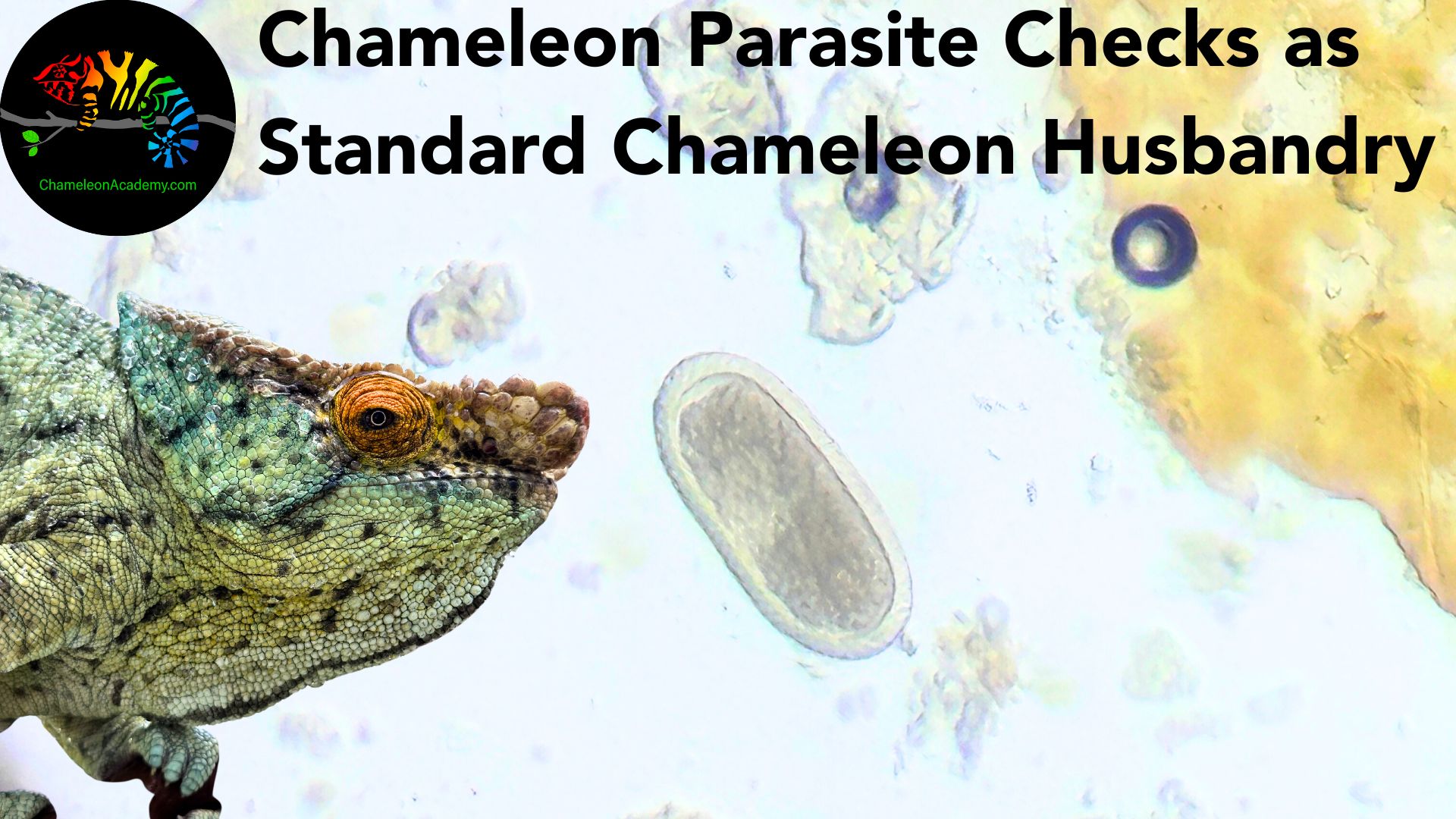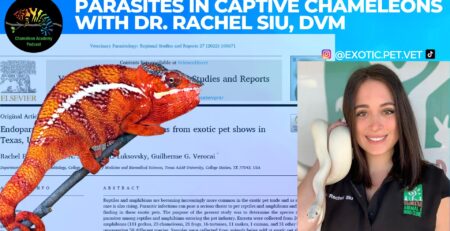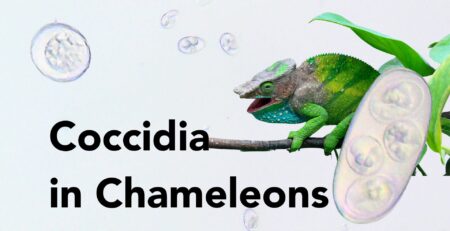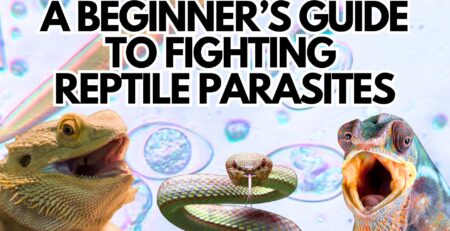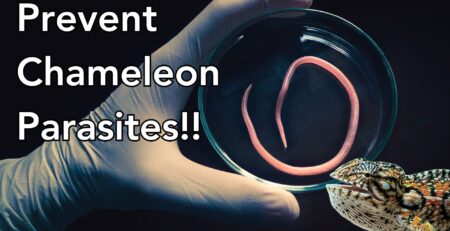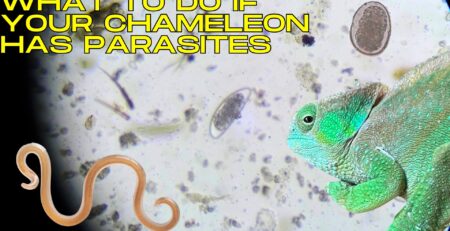Parasite Checks: Why you should do them for your chameleon
Doing your own parasite checks on your chameleon has long been for advanced keepers. But there is no reason why this cannot be a part of every day chameleon husbandry for anyone with multiple chameleons.Today I am making the argument for adding fecal checks to standard husbandry.
Embedded Podcast Player
My goal: Keepers doing their own chameleon fecal tests for parasites
Lately I have been talking a great deal about parasites in chameleons. The reason is that I think this is a serious aspect of chameleon health and, for many of our community, it is still a huge question mark. When you are told by the veterinarian that your chameleon has parasites you find it is a topic which is not well known by a great number of people. Of course, that is what the Chameleon Academy exists for. And so I have been creating a bank of parasite information references in podcast, YouTube video, blog posts, and even a comprehensive digital course. My goal with all of this is to elevate our general level of husbandry in the community.
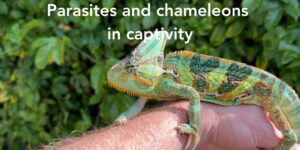
Parasites and Chameleons in Captivity
Of course, we have been doing fecal analysis for decades so I am not saying that doing a fecal analysis for parasites is anything revolutionary. What I am proposing, though, is that we make it common place for serious keepers and, especially breeders, to consider having a microscope a standard part of their husbandry. The benefit of this is actually community wide. It is well known, at least by some, that there is a thriving population of parasites in our captive population of chameleons.
A very good paper published by Dr. Rachel Siu, who many of you know as @exotic.pet.vet on Instagram and TikTok, documented the parasites found in captive hatched/born reptiles at a reptile show in Texas. There was a great diversity of parasites found – even in crested geckos who have been bred in captivity for multiple generations. So these are no longer the parasites they came with, but the parasites they picked up here. You can check out her study on her LinkTree. Click and scroll down to
Reptile Parasitology Research Paper
Jonathan Hill of iPardalis made there rare move of publicly documenting his battle with coccidia in his chameleons which, by the way, were 100% captive hatched. He had, at that point, never had a wild caught chameleon. These are just the public facing examples. You can read Jonathan’s documenting of this ordeal here: Why Captive Bred Panther Chameleons Still have Parasites
Privately, I have heard and consulted on many confidential panics when parasites were found in large collections. Obviously, the consequences of admitting to having parasites could be severe. That said, Jonathan has shown that there is life after that very painful bump and even, perhaps, a stronger business as now he represents a source where you know the breeder is 100% fully aware of parasites, is actively checking on them, and will be up front and honest about it. Now, this isn’t meant to be an advertisement for his business. But I have no problem openly sharing the event and the results because I do think that it is an example of what our breeding community can become with greater education on both the breeder’s and the community’s sides. This is an area of significant growth for us as a community and greater awareness of parasites will only create an increased quality of life for our chameleons. Both at the beginning of life at the breeder’s facility and in the care of its forever home. So it is something worth taking seriously.
What is a chameleon fecal analysis?
To cover all bases, I am going to lay out what I am talking about when I say doing a fecal analysis. This is where we take the chameleon poop and we put it under the microscope and look for infectious organisms. The major things we are looking for are live worms, the eggs of the worms, live parasitic protozoa, and cysts or oocysts for various protozoa. Checking the feces is the way we do it because it is how the internal parasites send their eggs out into the world to find other chameleons to infect. Although slightly disgusting, it is convenient to have so much parasitic evidence in one place.
Now, the endoparasites, meaning the internal parasites, that send the results of their reproduction out the back end represent the bulk of parasites, but we need to keep in mind that there are blood borne parasites and parasites that have gotten lost in the body captivity somewhere that will not be detected in the fecal analysis. Today I am limiting my discussion to the fecal analysis. That is our first step. Once you have that under your belt we can expand our parasite search. But, for this post, let’s concentrate on the first step of doing fecal analysis.

Tools for doing a fecal analysis
And it really isn’t that hard to get set up to do a fecal analysis. You need a microscope with transmitted light, meaning light from below the slide, that gives you between 100x and 1000x magnification. You can get this for between $150 and $300. Finding a microscope that meets these requirements is very easy. In fact, the danger is you being overwhelmed by the choices. The good news is that you only need the basic functionality for what we do. The more expensive microscopes are doing things beyond what we need. Here is your quick list of features that I look for in my microscopes
Eyepieces: How many eyepieces you get is total up to you. I get either two eye pieces for both eyes or three eye pieces for the addition of a digital camera. But this is personal preference and will not affect you finding parasites.
Magnification: Nematodes, meaning parasitic worms, and their eggs can be seen at 100x magnification. Flagellated protozoa and coccidia can be comfortably identified at 400X magnification. So, even just a 100x and 400x capability would serve you adequately. But I like to get at least 1000x magnification. Now, remember that total magnification is the eyepiece magnification multiples by the objective magnification. These are compound microscopes meaning magnification is in two places. The eyepiece which you are looking into and the objective, which is the lens pointing at the slide.
Transmitted light: So, this is required. You need the light under the slide. The other type is Reflected, or incidental, light which comes from above the slide. These are for different use cases. Your use case requires transmitted light so make sure you check that the feature list lists transmitted light or you see in the picture the light under the slide.
Mechanical Stage. The stage is what is holding the slide on the microscope. It is an extra feature to have the ability to move it forward and backward or left and right. This is necessary so we can search the entire slide. This feature is called a mechanical stage.
Digital Camera: And, finally, consider the ability to add a digital camera. This isn’t totally necessary to do your job, but it has been invaluable to share with others and get their opinion as to what you might be seeing, and you can then bring the picture or movie in to your veterinarian appointment and your vet will get great information from the content you create. I have really enjoyed using the iPhone adapter and the majority of what I share on social media is from this adapter and my phone.
Beyond the microscope there is supporting items that are an easy find on Amazon or other general purpose online supplier.
The Direct Fecal Smear
There are two methods commonly used to analyze the feces. The first is the Direct Fecal Smear. And this is where you are rubbing the feces on the slide to get just the smallest amount of material on the slide. You want to be able to put a coverslip on and you can’t that with a nugget sitting on your glass slide. A drop of saline makes sure that any life in the sample can comfortably swim around. And this is what you want because movement is the way you’ll be able to identify the flagellated protozoa. You can see everything in the Smear from nematodes, cestodes, entamoeba, protozoa, and coccidia, but the float is optimized to see these others items. The only place you will see the flagellated protozoa is the smear. So, we concentrate on looking for wildly frenetic dots gyrating about at 400x to 1000x when we are looking at the smear.
The Fecal Float
The fecal float is a technique where we break up all the fecal material that is placed in a sodium nitrate solution. In this solution, the fecal material sinks and the parasitic eggs and cysts float. So a coverslip placed on the top of the fecal disruption tube collects all the eggs and oocysts and such. Though the Sodium solution will kill most life so that is why you will not be able to see the flagellated protozoa. They are there, they are just dead and so are extremely difficult to identify. This test specializes in the eggs and cysts.
Now, I am just explaining these in broad terms because this episode is not meant to be a tutorial. I am giving this context so we are all on the same page, but today I am wanting to propose a concept. There are many places to find tutorials once you agree that this is something that is valuable for us to integrate into our husbandry. I made an entire class that goes through this step by step so, please allow me to defer to those other sources for detailed how-to.

Why is fecal analysis worth adding to our chameleon husbandry?
If you only have one captive bred chameleon then you can just do an annual fecal check through your veterinarian and you will be fine. But if you start to add to your collection and start thinking about breeding your chameleons you are starting to step to the next level of seriousness. You are bringing in chameleons from different sources and what one has the others are in danger of catching. Parasites can definitely be managed, but you have to know they are there to know that you have to manage them. Of course, we should be implementing strict hygiene practices that will disrupt the parasites lifecycles at all times, but that requires a level of resolve that sometimes might waiver. Knowing there is a problem will help the resolve.
The most important aspect about doing your own chameleon fecal checks is that you can catch any infection before it becomes a problem. We all know, we generally check for parasites when our chameleon starts to become lethargic or close their eyes and we are trying to figure out what is wrong. Well, we all know that once we see symptoms that the infection has been going for a long time and has reached the point where the chameleon can’t hide it any more. By then we have a full blown overpopulation of parasites and need a major medical intervention. But, if you are doing fecal checks every month you will find those parasites when the infection starts and your chameleon is still at the peak of health. A chameleon at the peak of health will recover quickly and it is not a big deal. A chameleon who has a raging parasite infection to the point where they are closing their eyes is now in danger of not making it back out. So, doing your own chameleon fecal checks puts you ahead of the curve.
A special note to chameleon breeders
If you are a breeder or have a desire to breed chameleons then doing your own fecals should absolutely be on your to-do list. We have a prevalence of parasites in the community because we rarely check for them. Of course, we assume that captive bred means clean of parasites. And, unfortunately, that is not the case and if we never check and we breed and we send them out and no one ever checks you can see how any of these parasites could just spread unhindered to captive bred populations. You as the breeder are in a position to ensure that you are not contributing to this issue. And, to put a cherry on top, the last thing you need for your breeding project is for your customer to find the parasites instead of you. More and more people are getting microscopes because it is enjoyable so I suspect we will see more and more discoveries of parasites where they are not expected. Now is a very good time for you to get ahead of this and firmly place yourself on the side of ensuring that your chameleons are clean.
A special note to chameleon keepers
Now, on the other side. If you are a keeper and you are buying captive bred chameleons you probably expect them to be parasite free. This is a reasonable expectation. Getting a microscope and doing your own chameleon fecals may bring a surprise. And if you have just finished that huge bioactive enclosure that your chameleon is now running around in, finding coccidia is not welcome news.
So, here is the thing. As we move forward to breeders being more on top of actively checking for parasites we also need to bring a certain perspective from the general community. We will, most likely, never be free of parasites in our chameleons. They go deep and the medicines don’t always catch where they are. They don’t always shed all the time so, even though we do three negative fecals, the chameleon may still have parasites hidden deep inside. Small protozoa can have a life of weeks while nematodes can have a life measured in years. In fact, some nematodes are being studied for their resistance to aging. What I am trying to do is say that even if your breeder is working hard to do the best they can, we need to do our part and be realistic with regards to parasites. Part of that is also realizing that once the chameleon is in our possession, the only way to be sure that the parasites actually came from the breeder is to test the poop that may have been deposited in the shipping container. After that, there are numerous ways that you could be transporting parasites without knowing it. I am sure the world will love to point fingers that the breeder because someone has to be at fault, but I am hoping that this exposure to more information does not just lead to more drama. Breeders, do your part by being proactive in checking for parasites and community, let’s do our part by continuing the checking. The think is, that when we have a chameleon we are also signing up for a constant battle against parasites. And before you think you are immune from parasites, all it takes is to have gone to the reptile show last year where you touch the bathroom door knob, and you may have some coccidia oocysts already at home waiting for the signs hat they have hitched a ride with a cricket and are now in a chameleon. And, yes, they are really that bad.
My vision for small batch breeding
This push for more awareness of the internal health of our chameleon also goes hand in hand with my desire to experiment with how we can make small batch breeding a successful approach in the chameleon community. Part of this is the idea of raising each baby from the moment of hatching in enriched luxury. In this proposal, there is a tight knit group of chameleon herpetoculturists that specialize in raising babies and they would do a maximum of 6 to 12 or how ever many they desired and had individual enclosures for. In doing this, every baby would be given top attention to their growth. They would also be constantly monitored for any parasite activity. It is possible that vertical transmission occurs where the mother can spread coccidia to her babies. I do not believe we know this happens, but we are seriously evaluating this. That would mean we need to be vigilant for any hatchling. Would the community embrace dedicated baby raisers? Would you pay what it cost to know that the chameleon baby you are bringing home was fully enriched growing up and individually monitored for parasites and any health issue? I would love to see breeders competing for who can produced the highest quality baby both physically and emotionally.That seems to me a better world than breeders having to cut prices and services to compete with breeders who do less. The world we create in the next chapter of chameleon husbandry depends 100% on what we as a community are willing to pay for. Right now you can command up to $1000 and even more for the craziest colors. I don’t know that we can ever convince the general populace that quality of life, which cannot be measured and usually can’t be seen, is worth investing in. But, I am going to try it. Me and my merry band of Calummanati are going to do it and what the world does with our experiment is yet to be determined. But, at least we will have tried something new!
The Next Steps
Okay, say you agree that this is important and you want to learn to do your own chameleon fecal tests. The cheapest way to do it is to buy the book Understanding Reptile Parasites by Dr. Roger Klingenberg. Make sure you get the second revision. It is massively upgraded from the first edition. This is a great reference and is readily available on Amazon in the US, at least. In that book he will share with you what you need to do and give you a run down on parasites.
If you would like more of a personal community touch I created a digital course on a community platform that you can take called Hunting Microscopic Chameleon Parasites. This course assumes you have no background and explains the chameleon/parasite relationship, the parasite lifecycle, how to purchase a microscope, the equipment, how to do a smear and float, how to identify parasites, the medicines we use, how to quarantine, clean, and be a full partner with your veterinarian so you both can discuss on a educated level the health of your chameleon. The special thing about this course is it is community powered. You are taking the classes whenever you want and at your own pace, but you are not alone. Each lesson has a comments section in which I respond and there is a discussion group where you can hang out with me, fellow students, and alumni who are putting what they learned into practice. So you are seeing real world case studies as you are going through the material. This is specifically designed to make sure you are able to do your own chameleon fecals by time you graduate the course. This is a paid course on a professional community course platform.
Any purchase of this course directly supports the chameleon academy outreach and I thank you for that.
Conclusion
So, I know this is a new concept for many of us. Sure, we knew parasites were a thing, but probably wasn’t as real of a thing as I am saying it should be. This doesn’t have to be a big deal for most chameleon keepers. An annual chameleon fecal check at your vet is probably good enough. But for those of you who feel that chameleon herpetoculture is something we want to refine ourselves in, learning to use the microscope is a big next step which, by the way, is incredible cool and fascinating. Once you start learning the world of parasites you find another addiction. I do chameleon fecal analysis every other day and sometimes multiple times a day. I put on some good music and search the slide for those microscopic creatures. There is a sense of satisfaction in knowing my chameleons that well.
Thank you very much for joining me for this step into a new chapter of our community. Even through this course I am seeing the number of keepers and breeders who are diving deeper into this increase. So, here is your invitation to be one of the trend setters. I am not much for trends, but this one will give our chameleons better lives. So I am excited to see this one develop!

